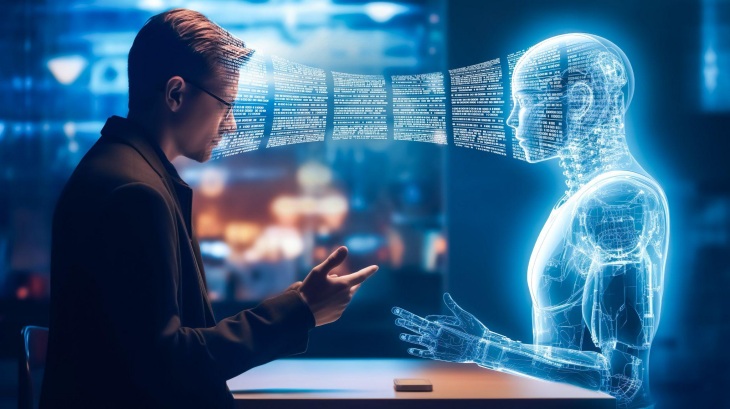
Ever since Chat-GPT launched to the public I’ve been somewhat obsessed with artificial intelligence and its potential uses. Less than a year since that release we’ve already seen quite a few use cases emerge, with many others on the horizon. Here’s just a small sample of the growing use case list:
- Generate ideas
- Translation
- Content creation
- Chat bot
- Customer support
- Debugging
- Ecommerce websites
- Educational applications
We’ve also seen how AI usage is growing in areas such as medicine and finance, with the potential to completely revolutionize both fields.
The current problem being faced by AI companies is the high cost of model training, but as those costs decrease – and I’m sure they will – the number of AI agents is going to become vast. AI agents will outnumber humans online (if they don’t already) and those agents will consume, generate, and exchange an unimaginable amount of information.
The question then is how can we ensure that these AI agents reach their full potential, while also allowing humans to identify AI agents online, and then audit and control the actions they take.

The current state of affairs sees companies like OpenAI covering their massive costs by charging API access to the AI models they create. However, this is not scalable if we expect to have millions, or even billions, of specialized AI agents roaming the online world and transacting with each other. We need a way to enable AI agents to freely transact and complete tasks without direct human interaction for the myriad of tasks they will be expected to complete. And of course we will want to identify, control, and audit their actions.
This last is a problem known in the AI world as AI alignment. AI alignment is defined as the method to ensure artificial intelligence systems achieve desired outcomes. Not just that, but these outcomes should also be in-line with humans’ intended goals, preferences, or ethical principles. Once we can get alignment right it opens up a whole new world for AI agents.
The Solution for Aligned AI Agents
Currently we can’t allow our AI agents to use traditional financial systems because they don’t fit with the identity model used in these systems. This greatly limits the ability of AI to interact within financial systems. It’s also been noted that AI consumes a huge amount of online resources, thus creating additional costs, but is unable to generate revenues in the traditional sense by subscribing to services or clicking on ads. If we can solve this dilemma then AI can not only pay for itself, but it could generate more revenues to become profitable.
This solution requires three things:
- A new software model where trusted code execution is guaranteed and is auditable;
- A new digital financial system that not only serves humans, but can also serve AI agents;
- A cryptographic identity model that includes decentralized communication and reputation protocols.
Currently the best way to achieve these three things is through blockchain protocols and smart contracts.
Combining Blockchain and AI
Blockchain is already providing us with numerous financial services through smart contract interactions. Major blockchain platforms like Ethereum, Solana, Avalanche and others allow for secure, reliable decentralized applications, with an auditable trail of transactions. These networks already see tens of billions of dollars in value locked, along with hundreds of thousands of daily transactions.
Other networks such as Filecoin and Arweave can provide cheap, secure data storage, which will be key for AI models going forward. As the technology continues to improve we should see increased development on all the blockchain platforms, leading to an ever expanding range of available services.
Because these platforms rely on smart contracts, which are themselves self-executing code, it seems a small step to take to use these networks to train, deploy and operate decentralized AI agents that are able to interact with each other through the smart contracts. Certainly this is much easier and financially stable than the current model that requires the use of Web2 REST APIs. Future AI agents could instead operate through smart contracts, paying small fees – in the form of digital tokens – as they go along with their tasks. This not only improves the efficiency of the AI agents, it also increases the usage of the blockchain that the smart contracts reside on, a win-win scenario.
Creating AI agents that can control their own digital wallets would mean they could easily use any smart contract based platform or service, including DeFi protocols and infrastructure services. This alone could open up a whole new universe of use cases and business applications. A wallet-enabled AI agent would be able to pay for its required resources, whether those are computational or data related.
Such an agent could even invest the tokens it holds, through staking or yield farming protocols, or through trading on decentralized exchanges. This would allow for optimization of the financial operations of the agent, while also increasing liquidity in markets. Depending on the function of the agent itself it could theoretically charge other agents for its services. The end result would be a vast network of economically incentivized AI agents, all working together over decentralized protocols, trading data and services while covering their own costs. This is something that’s impossible to even consider using the current traditional financial systems.
Consider the Benefits of Blockchain AI Agents
Even when AI agents are delivering their benefits offchain, if they are doing the work onchain we end up with an immutable record of their activity that’s publically available and transparent. This will allow for the safe deployment of AI agents, with no questions regarding what they might be doing online. This can provide a host of benefits, including the ability to distinguish AI activities and content from human, build identity systems for AI agents, and audit agents actions and created reputation systems for AI agents. We would be able to reward the good actors within this system, punish or remove bad actors, and know with certainty which agents perform best at a given task. Not only will humans know which agents to trust, but other agents will easily determine which agents to trust and rely on based on the publically available onchain history of any given agent.
Of course much work needs to be done to get to this point. While blockchain infrastructure is becoming faster and cheaper, we would need to scale smart contract blockchains to handle all of the transactions AI agents would create. Smart contract programmable wallets are being developed that will help agents in transacting with smart contracts and other agents. One of the key features of these newer wallet types is the ability to integrate account abstraction that would allow human actors to authorize AI agents to spend from a given wallet.
We would also need to build the registries and reputation systems needed to track AI agents, most likely using their public keys as the identifiers for each specific agent. Once that’s underway I would expect to see a number of new business applications and models emerge.
Investor Takeaway
Yes, there is work to be done, but all of these developments, while they may seem out of reach now, are likely just around the corner. And once the floodgates open so many more blockchain/AI interactions will likely become obvious to us, ushering in a new financial system that is more open, more transparent, more efficient, and ultimately more tuned to the needs of humanity.
If you believe, like I do, that a combination of blockchain and AI is inevitable, then it’s likely you can also see how this would impact on the value of various blockchain platforms and protocols. How this activity will generate massive onchain value, lifting the value of the tokens needed to transact within these AI-powered systems. We’ve always looked to mass adoption of blockchain, but none of us expected that this mass adoption might be more AI-based than human-based. Either way, it will drive the value of the underlying blockchains, creating opportunities for those of us that have the imagination to see them.
- SEO Powered Content & PR Distribution. Get Amplified Today.
- PlatoData.Network Vertical Generative Ai. Empower Yourself. Access Here.
- PlatoAiStream. Web3 Intelligence. Knowledge Amplified. Access Here.
- PlatoESG. Carbon, CleanTech, Energy, Environment, Solar, Waste Management. Access Here.
- PlatoHealth. Biotech and Clinical Trials Intelligence. Access Here.
- Source: https://www.bitcoinmarketjournal.com/blockchain-and-ai/



